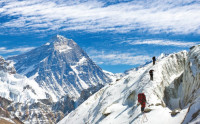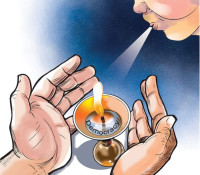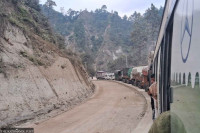Opinion
Problem in the air
Last November, New Delhi was forced to declare an emergency because air pollution became so bad that schools had to be closed for three days.
Binod Rayamajhee
Last November, New Delhi was forced to declare an emergency because air pollution became so bad that schools had to be closed for three days. Similarly, last December, Beijing declared a red alert and school children were told to stay home. Kathmandu is no more a pleasant place either. Pollution Index 2016 called Nepal’s capital the third most polluted city in the world after Tetovo, Macedonia and Cairo, Egypt.
Kathmandu is highly vulnerable as it is a valley. The surrounding hills restrict proper wind movement and trap pollutants inside. Air pollution has become a serious environmental concern and a public health risk. The valley has observed rapid urbanisation and population growth in the last few decades. The annual population growth rate in the Valley is 4.7 percent and the annual motorisation rate is 12 percent. Air pollution has increased due to haphazard urbanisation, rapid motorisation, valley-centric industrialisation and topography. Air pollution has now become the biggest environmental cause of premature death, overtaking poor sanitation and lack of clean drinking water. A health research based on samples of total suspended particles collected in 2013-14 showed that the Kathmandu Valley has a high amount of polycyclic hydrocarbons which are mutagenic and carcinogenic.
Major sources
The main sources of particulate pollution in the Valley are brick factories, domestic fuel combustion, vehicle exhaust, re-suspension of road dust and industrial boilers. Moreover, the number of motor vehicles in the Valley has swelled severalfold in the past few decades. Automobiles are the main source of air pollution in Kathmandu. Places with heavy motor traffic are the most polluted, and pollution levels drop significantly during weekends and bandas when there are fewer vehicles on the city’s roads.
As diesel exhaust is very hazardous for human health and it contains fine particles, diesel-burning vehicles should be avoided as far as possible. The government should introduce economic tools, such as fuel tax, to discourage the use of diesel vehicles. Air pollution directly affects human health. People mostly suffer from illnesses related to the respiratory system. Some pollutants are actually toxic, for example, hydrogen sulphide, fluoride and arsenic. Most commonly, there is irritation of the throat and lungs, coughing, lesions of the respiratory tract and, in severe cases, death from respiratory failure. With regard to heavy metal, certain forms of mercury and lead attack the central nervous system and affect the lungs while antimony affects the heart.
The Kathmandu Valley’s ambient air has been found to be polluted with particulate air pollution. Particulate matter, or PM, is the term for particles found in the air, including dust, dirt, soot, smoke and liquid droplets. In terms of medical science, PM-2.5 is considered to be a life killing carbon. Normal surgical masks can’t block PM-2.5 from being inhaled while N-95 mask can prevent it, but the cost is high. According to World Health Organisation (WHO) guidelines, the amount of PM-2.5 should not cross 10 micrograms per cubic metre air, but in the Kathmandu Valley, it is eight times the maximum permitted level at 80 micrograms per cubic metre air. Some studies have shown that during load-shedding hours, the PM-2.5 level is even higher.
Government’s role
Monitoring of gaseous pollutants such as nitrogen dioxide, sulphur dioxide and carbon monoxide showed that their concentrations too exceeded national and WHO limits. The Department of Environment under the Ministry of Science, Technology and Environment in association with the International Centre for Integrated Mountain Development (Icimod) has installed air quality monitoring equipment at Ratna Park, Pulchok and Dhulikhel.
The major sources of particulate air pollution in the Valley are dust re-suspension from vehicular movement and human activity, and emissions from old motor vehicles and cement and brick factories. Several studies have also shown an association between PM pollution and health effects in Nepal. A statistical analysis of the results showed an increase in cases of chronic obstructive pulmonary disease and hospital admissions with complaints of chronic obstructive pulmonary disease, asthma, pneumonia and bronchitis. Introducing environment-friendly brick kilns can significantly reduce the amount of pollutants in the dry winter season. Promoting ecofriendly vehicles can reduce the amount of pollutants significantly too. The government should work to make the people aware about air pollution.
Rayamajhee holds an MSc in medical microbiology from TU




 5.31°C Kathmandu
5.31°C Kathmandu












